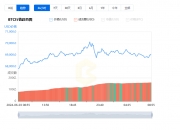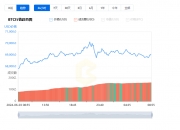什么是区块链呢,本质上讲,区块链是一种分布式、去中心化的网络数据库系统,这个系统会让数据的存储、更新、维护、操作变得不同。
What is a block chain? Essentially, the block chain is a distributed, decentralised web-based database system that makes data stored, updated, maintained and operated differently.
我们今天要讲的区块链呢,它有四项不可缺的核心技术,分别是:分布式存储、共识机制、密码学原理、智能合约。
What we are talking about today is the chain of blocks, with four essential core technologies: distributed storage, consensus mechanisms, cryptography, smart contracts.
那么我们今天就讲一讲,与传统数据处理相比,区块链到底有什么不同,帮助大家了解区块链是什么,让大家对区块链有一个总的认知。
So let us say today, how the chain of blocks is different from traditional data processing, helping to understand what the chain of blocks is and giving you a general understanding of the chain of blocks.
一、区块链中的数据存储:块链式数据结构
在数据存储方面,区块链技术利用的是“块链式数据结构”来验证与存储数据的。块链式结构是什么意思呢?铁链子大家都见过吧,一环套一环那种,其实,每一环我们可以看作是一个区块,很多环节扣在一起就形成了区块链。
In terms of data storage, block chain technology uses a "block-chained data structure" to verify and store data. What does a block-chain structure mean? The chain has been seen by everyone, in a chain of rings, and in fact, each ring can be seen as a block, and many links are tied together to form a chain of blocks.
区块里存储的是数据,和普通存储数据的不同之处在于:在区块链上,后一个区块里的数据是包含前一个区块里的数据的。
The difference between data stored in blocks and data stored in general is that, on the block chain, the data in the latter block contains the data in the previous block.

以读书为例:我们平时看书,看完第一页,接着读第二页、第三页……那在区块链里面呢,如果给每个区块标注上页码,那么第二页的内容是包含第一页的内容的,第三页的内容包含第一页和第二页的内容……第十页包含了前九页的内容,就是这样一个层层嵌套的链条。这样一来,就可以追溯到最本源的数据了,这就是区块链的可追溯性。
Take reading as an example: we read the book, read the first page, then the second page, then the third page in the block chain. If each block is marked with a page number, then the second page contains the first page, and the third page contains the first and the second page. Page 10 contains the first nine pages, which is a chain of layers. This allows us to trace the data from the most sources, which is the traceability of the block chain.
二、区块链中的数据更新:分布式节点共识算法
在数据更新方面,区块链技术是利用“分布式节点共识算法”来生成和更新数据。
In terms of data updating, block chain technology uses the Distributed Node Consensus algorithm to generate and update data.
每每生成新的区块(也就是更新数据的时候),都需要通过一种算法获得全网51%以上节点的认可才能构成新的区块,说白了就是投票,超过半数人同意就可以生成。这就使得区块链上的数据不容篡改。
Every new block (i.e., when the data are updated) needs to be accepted by more than 51 per cent of the net through an algorithm to form a new block, which means voting, with more than half of the people agreeing to it. This makes the data on the block chain immutable.
我们还是打一个比喻来解释:我们把区块链比作一个账本,因为都是记录数据的嘛。传统世界里,记账权在于记账先生,账本属于记账先生一个人的;在区块链里面,每一个人都拥有这个账本,大家一起来记账,想要更新账目呢,就要投票,半数人以上赞成才可以去更新账目数据。
Let us explain by a metaphor: we compare the chain of blocks to a book of accounts, because it's all data records. In the traditional world, the book of accounts is left to Mr. Books, and the book of accounts belongs to Mr. Books alone. In the chain of blocks, everyone has the book of accounts, everyone takes it together, and if you want to update the accounts, you have to vote, and more than half are in favour of updating the account data.

在这个过程中,我们会涉及到这么几个名词:分布式、节点、共识算法:
In this process, we are dealing with the following terms: distribution, nodes, consensus algorithms:
每个人都记账(也就是人人拥有账本,账本分散在每个人手里)这就是所谓的“分布式”;大家讨论、投票产生的、一致赞同的记账办法,就是所谓的“共识算法”;节点就更简单了,参与记账的每一个人就可以看做是一个节点。
This is the so-called “distribution” of everyone's bookkeeping (i.e. everyone owns the book and the book is spread out in everyone's hands); the way in which you discuss, vote for and agree with the bookkeeping is the so-called “consensual algorithm”; the node is simpler, and everyone involved in the bookkeeping can see it as a node.
三、 区块链中的数据维护:密码学
接下来到了数据维护阶段,区块链的不同之处就在于:它利用密码学的方式来保证数据传输和访问的安全。
The next step in data maintenance is that the block chain is different: it uses cryptography to secure data transmission and access.

那么,区块链中所应用的密码学原理主要有以下这么几个:哈希算法、Merkle哈希树、椭圆曲线算法、Base58。这些原理,其实呢,他们都是通过一系列复杂的运算以及换算,来保证区块链上数据安全。
So the cryptography principles applied in the block chain are mainly the following: Hashi algorithms, Merkle-Hashi trees, elliptical curve algorithms, Base58. These principles, in fact, guarantee data security in the block chain through a series of complex calculations and conversions.
四、 区块链中的数据操作:智能合约
最后就进入到了数据的操作阶段,也就是我们接着要说的“智能合约”。
And finally, we're at the operational stage of the data, which is what we're going to call “intellectual contracts”.
智能合约,是由计算机程序定义并自动执行的承诺协议,说白了,就是用代码执行的一套交易准则,类似于现在的信用卡自动还款功能,开启这个功能,你自己什么都不用管,到期银行会自动扣除你欠的钱。
Smart contracts, a commitment agreement defined by a computer program and automatically executed, are a set of transactional guidelines implemented by code, similar to the current credit card automatic repayment function, which opens up, you don't have to worry about anything, and the maturity bank automatically deducts the money you owe.

智能合约的突出优势就是,很大程度上避免了由信任产生的一系列问题。我们很多人,都遇到过被借钱的事情:朋友手头紧了跟你借2000块钱,承诺下个月发了工资还钱,到了下个月他又找别的借口不还,拖来托去这事儿就没谱了。本来没多少钱,还是朋友,虽然你很郁闷,这事也就算了。
The obvious advantage of a smart contract is that it largely avoids a series of problems that arise from trust. Many of us have experienced borrowed money: a friend who's got 2,000 dollars to borrow from you, promised to pay you his salary next month, and next month he's got another excuse not to pay it, and it's not going to work. It's not going to work. It's not going to be much, it's going to be a friend, even if you're upset.
那么,有了智能合约以后,他就不能赖账了,因为在智能合约上,一旦触发合约中的条款,代码就会自动执行,不管他愿不愿意,只要他发了工资、账户上有了钱,他就得还你。
So, with a smart contract, he can't afford it, because in a smart contract, once the terms of the contract are triggered, the code is automatically enforced, whether he wants or not, and he's gonna pay you back as long as he pays and he has money on the account.
最后总结一下今天的内容,今天呢我们主要通过数据存储操作的这么一个流程,介绍了区块链的基本情况。我们对此做一个总结,可以发现区块链中有四项不可缺的核心技术,分别是:分布式存储、共识机制、密码学原理、智能合约。
Finally, to sum up what we're doing today, we're doing, mainly through this process of data storage, to describe the basics of the block chain. To sum up, we can see that there are four essential core technologies in the block chain: distributed storage, consensus mechanisms, cryptography, smart contracts.
那么,我们可以这样理解:分布式存储对应的是数据存储这个阶段,共识机制对应的是数据的处理更新这个阶段,密码学对应的是数据安全,智能合约对应的是数据的操作问题。
So we can understand that distributed storage corresponds to the data storage phase, consensus mechanisms to the data processing update phase, cryptography to data security, and smart contracts to data operations.
注册有任何问题请添加 微信:MVIP619 拉你进入群

打开微信扫一扫
添加客服
进入交流群




















发表评论